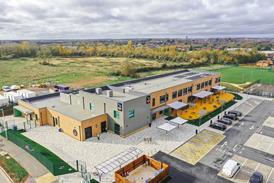NHS Trust security managers are under increasing pressure to combat hospital violence. Last year, there were 65,000 recorded incidents of violence against NHS staff, while UNISON, the public sector worker’s union which boasts a membership of around 240,000 NHS medical staff, claims 49% of its members were subjected to violence last year.
The alarming level of violence shows no signs of abating in 1999. In August, a nurse sustained a broken leg and three of her colleagues suffered injuries, after a man went berserk in the casualty department at West Middlesex Hospital in Isleworth. In February, Portsmouth NHS Trust took out a civil injunction against family members of a severely ill 12-year-old patient, after they assaulted two doctors, nurses and another patient at one of its hospitals. The list of incidents goes on.
Unsurprisingly, nurses are becoming increasingly reluctant to enter the profession — the NHS Executive has conceded that London hospitals are short of nearly 4,900 nurses, with fear of violence a major factor in deterring people from entering the profession. The Government, jolted by this alarming trend, recently launched an NHS Zero Tolerance Zone campaign in an attempt to reduce hospital violence.
The Department of Health has set Britain’s 402 NHS Trusts the job of reducing violence against NHS staff by 20% in 2001 and by 30% in 2003. Trusts are also are required to have systems in place to record violent incidents (so in future UNISON and the NHS might actually agree on what the real figures are). To that end, the NHS Executive has published a “Manager’s Guide” which outlines how hospital violence could be tackled. In the guide, the Government appears to lay responsibility for reducing violence against staff firmly at the door of the hospital security department. The guide urges NHS Trusts to install effective security systems and ensure both security and non-security staff are properly trained in how to handle aggressive patients and visitors.
Security overhaul
Chris Doherty is responsible for security at King’s College Hospital in south-east London, one of the UK’s largest NHS hospitals. Doherty welcomes the Government’s Zero Tolerance campaign and is confident King’s can achieve the targets set for reducing violence against staff, but knows his job won’t be an easy one.
Doherty implemented a ‘zero tolerance’ policy against hospital violence at King’s three years ago, encouraging staff to report every single incident of aggression against them. As a result the number of incidents of aggression reported by hospital staff has soared. Last year, there were 244 recorded incidents of verbal abuse against staff and 50 incidents of physical assault. This compares with 101 incidents of verbal abuse the previous year. In 1994-1995, there were no incidents of verbal abuse recorded and just one physical assault.
“It’s crucial that every hospital security department encourages medical staff to report violent incidents, so we are aware of the full extent of the problem,” urges Doherty. While reported violence at King’s has gone up, he believes the hospital is starting to get on top of the problem: “We’re convinced the new security measures we’ve introduced in the past three years are helping us reduce attacks on staff.”
Since 1996, Doherty has overhauled the hospital’s security, both in terms of technology and manpower. The nerve centre of King’s security operation is a £400,000 control room prominently situated, like a human goldfish bowl, behind the hospital’s main building reception desk, visible to all who enter. CCTV cameras, 96 of them covering all hospital sites and car parks, are controlled from here, while all staff have been issued with Pinpoint personal alarms so they can alert the control room immediately if they are being attacked.
The accident and emergency department — the newest in London — boasts a huge video screen above the entrance which displays the image of every person as they walk in to let them know they’re being watched. The A & E department also features a ‘soft’ room for disruptive patients.
Doherty asserts: “We’ve spent a lot of money on new security hardware, but it’s not just about spending more money — it’s also about a shift in attitude towards prevention and coming up with innovation to design out crime.”
Testing days
The key is getting the right security staff. Doherty has introduced “unique” recruitment days to ensure King’s employs security staff capable of handling aggressive patients or visitors. As well as testing prospective employees’ literacy, numeracy, IT skills and fitness, King’s uses an actor to play the role of an aggressive patient, in order to see how the prospective security officers would act in a ‘real life’.
The actor plays the part of a patient getting increasingly agitated at having to wait for treatment in a hospital’s casualty department.
The job candidate assumes the role of security officer and has to calm the man down by explaining the situation in a sympathetic manner.
However, when King’s put five applicants through
this test during a recent recruitment drive, three of them showed completely inappropriate responses, acting aggressively towards the actor and ordering him to sit down — one candidate was even on the verge of manhandling the patient into his chair.
'Many Trusts work in isolation... The NHS Executive doesn't have a security guru dealing solely with hospital security issues, but we need on urgently'
The test helps weed out applicants who lacked the ‘people skills’ for the job. “The interesting thing is, in the written applications they all had the right answers to questions on how to handle the situation,” Doherty comments. “If we hadn’t tested them under pressure using the actor, we might have deemed them suitable to work as security officers.”
Problems with training
King’s College Hospital opted to bring its security operation in-house in 1989. Doherty is proud of the personal safety training the hospital provides for non-security staff, and wants King’s to become a SITO-approved centre for security training. However, other NHS Trusts aren’t so confident about their staff training methods.
Many hospitals are confused over how to train their non-security staff in personal safety techniques so they can defend themselves appropriately. Anne Mitchell of UNISON claims: “There’s a lot of concern in the medical service over the types of training available and the suitability of training on offer — a number of course out their are too confrontational. We really need to agree on one standard, or a course that can be used by all.”
This view is shared by Erik Baskind, a director of and lawyer for the British Self Defence Governing Body (BSDGB). Baskind represents public sector staff in compensation claims against employers. He pursued 200 cases in 1998, a third involving nurses claiming compensation against NHS Trusts.
Baskind recently represented a nurse who seriously injured her right arm after a psychiatric patient slammed it in a door. The defendant — an NHS Trust — claimed its in-house training had been sufficient in teaching safe physical restraint and breakaway techniques.
However, Baskind successfully argued that non-physical techniques not taught by the Trust, such as confrontation management and de-escalation skills, would’ve helped the claimant deal safely with the patient. Baskind warns: “If NHS Trust don’t get training right, they could be paying out huge sums to injured nurses.”
However, a solution to the thorny issue of personal safety training may be near. SITO has set up a steering committee, comprising mainly personal safety training providers, to work towards standardising conflict management training for staff. The plan is to devise a SITO “Train The Trainers” qualification, so training providers that obtain the qualification will teach negotiation skills and physical restraint techniques to a certain standard.
Brighton Healthcare NHS Trust recently joined the steering committee and other hospitals have shown an interest in developing standardised personnel safety training, claims SITO business development manager Stefan Hay: “We’d be delighted to have more NHS Trusts in the steering committee. We’re an organisation providing training for the secure environment, not just the security industry, so hospitals come under our remit,” he says.
However BSDGB’s Baskind says the Government, not SITO, should be taking the lead on training standards for NHS staff: “It’s appalling that the NHS Executive has left personal safety training to the individual hospital,” says Baskind. “There has been very little guidance from up top and the [Zero Tolerance Zone] campaign is simply too vague in its instructions.”
Zero tolerance, little funding
The Government’s Zero Tolerance Zone campaign has also failed to impress Nick van der Bijl, head of security for Southmead NHS Trust in North Bristol. Like King’s College Hospital, Southmead has run a zero tolerance policy for the last three years, yet van der Bijl is critical of the Government: “It looks like the targets have been plucked out of thin air. We can reach the targets if we’re given the money to achieve them, but our hands are tied. We’d like to equip all our staff with mobile phones, for instance, but we cannot afford to do so.”
Van der Bijl reckons the problem of violence against NHS staff will only be properly tackled if the Government appoints an ‘NHS security guru’. “I do work with other Trusts in the south-west to share ideas, but many Trusts often work in isolation,” laments van der Bijl. “The NHS Executive doesn’t have a security guru dealing solely with hospital security issues, but we need one urgently.”
There is certainly evidence that some NHS Trusts are getting desperate in their bid to counter violence and badly need guidance. One NHS Trust recently decided to remove all drinks containing caffeine from its A & E department vending machines, in the vain hope it would prevent patients getting fuelled on caffeine and acting aggressively.
However it’s consumption of alcohol and drugs, rather than caffeinated drinks, which contributes most to violence in casualty departments, claims Bill Millar, part of the security team at Grantham and District Hospital NHS Trust: “It’s a sad fact of life that more and more people come to our unit for treatment under the influence of drink and drugs and treat our staff badly,” says Millar.
Anne Mitchell of UNISON contends that regardless of what security measures are introduced, progress in cutting hospital violence will only be made if the courts start handing out stiffer sentences to offenders: “We would like to see tougher penalties, as you would get if someone has injured a police officer. Nurses need special protection,” says Mitchell.
However, the Royal College of Nursing (RCN) isn’t convinced stiffer sentencing will have much effect: “Patients who attack nurses aren’t usually acting rationally,” says RCN spokesperson Sheila Brewer. “We need to concentrate on increasing security manpower, installing more security systems and improving personal safety training for nurses.”
Source
SMT




















